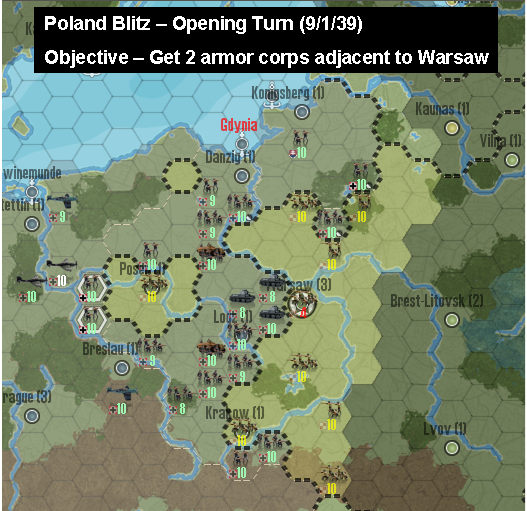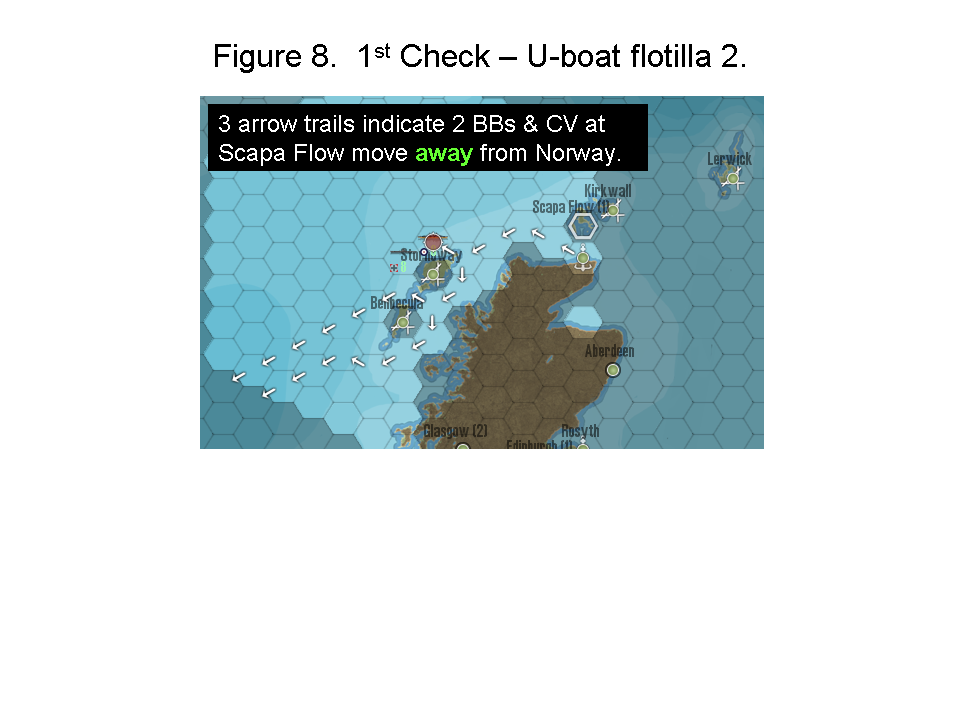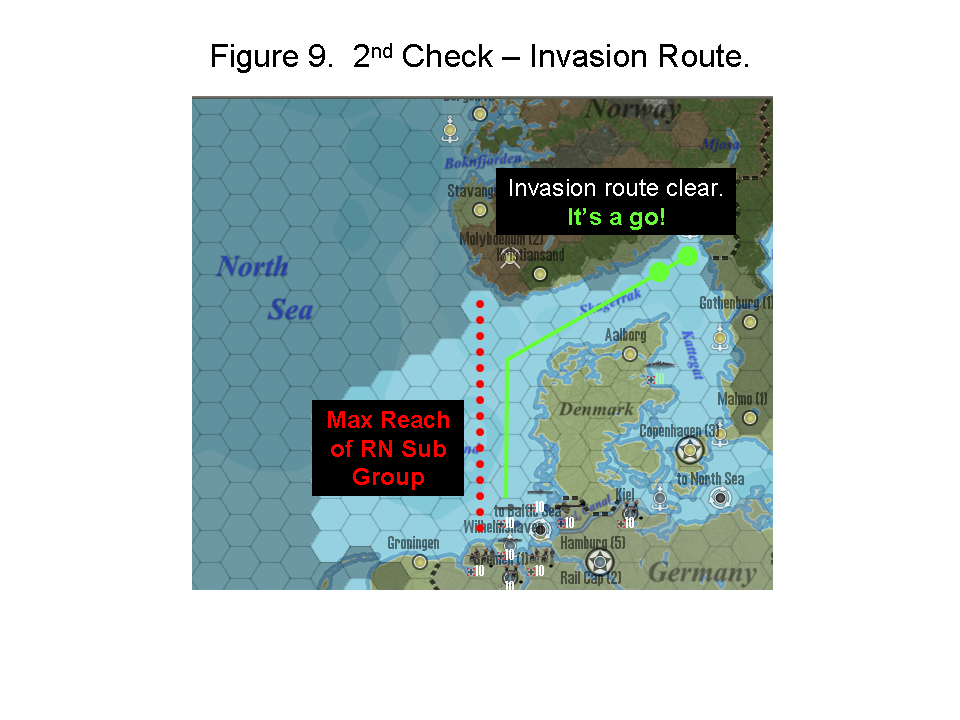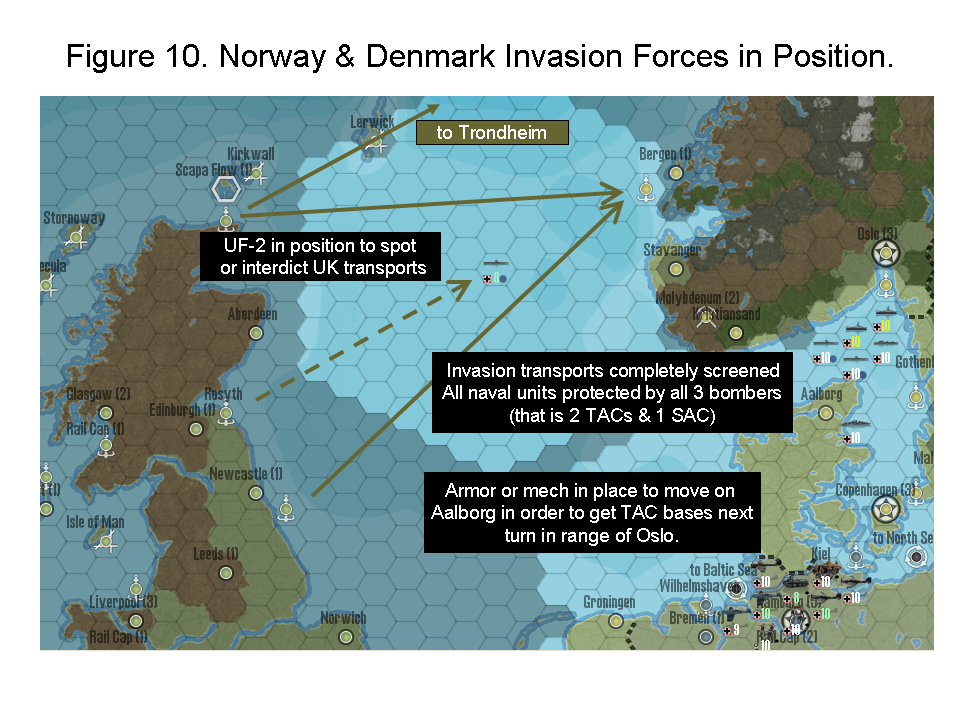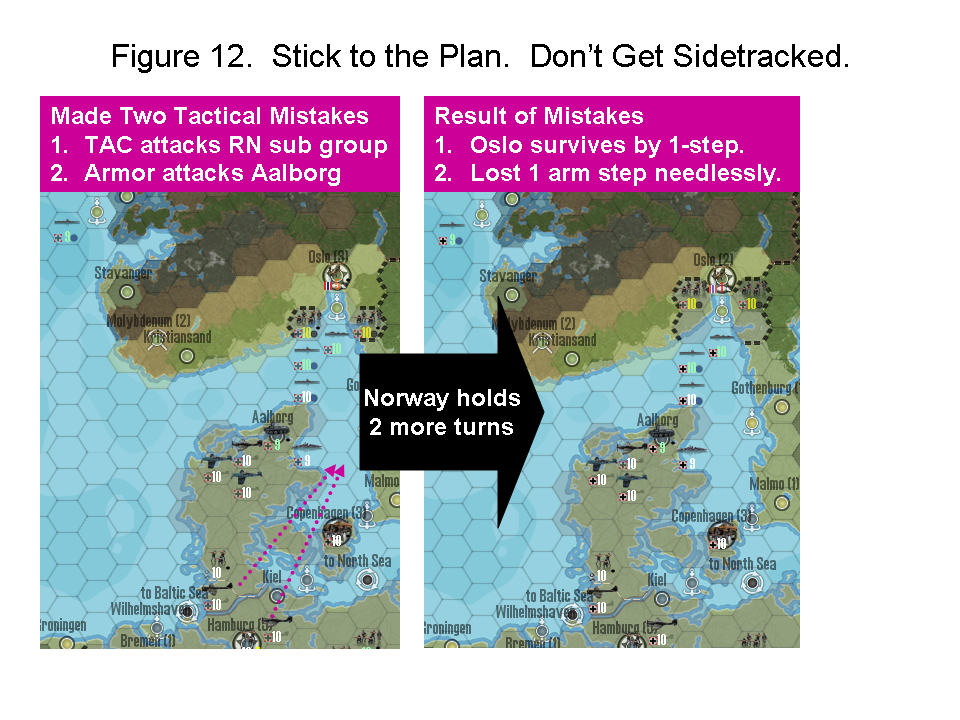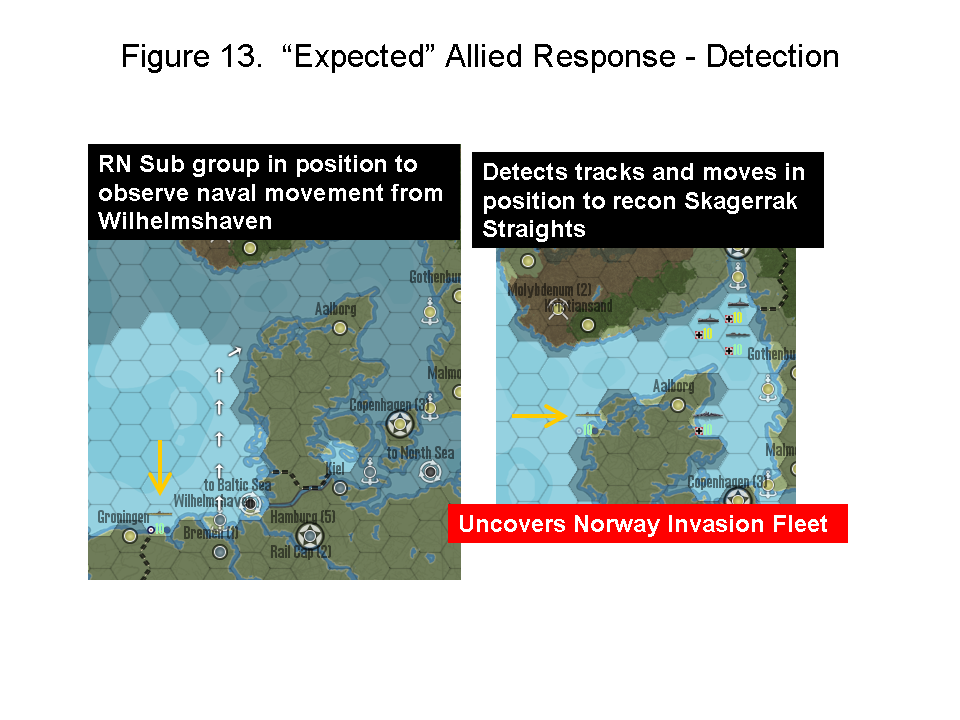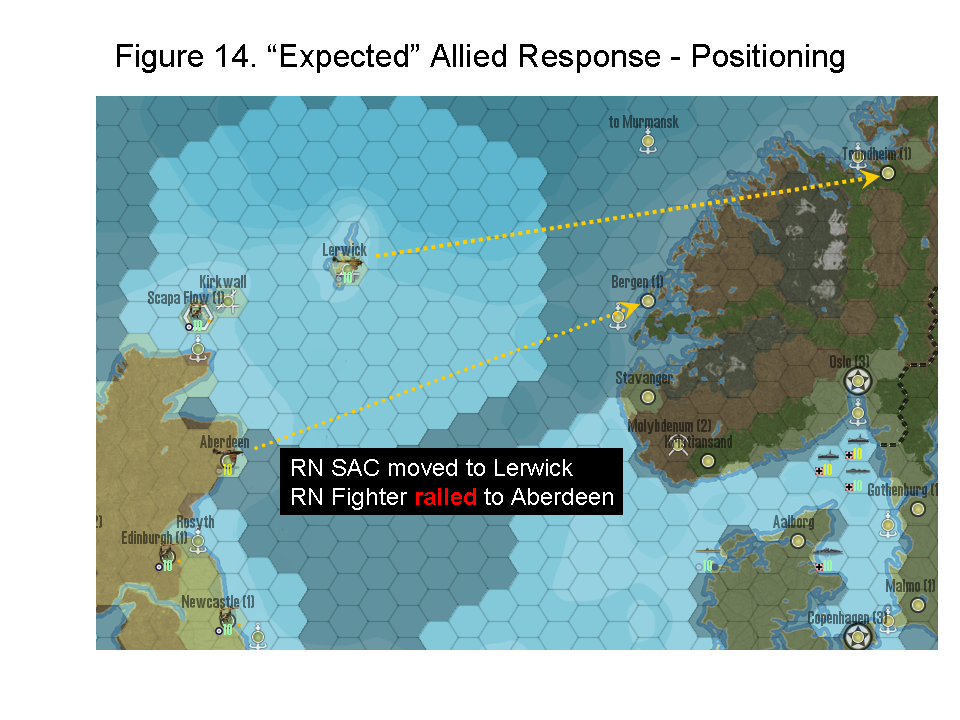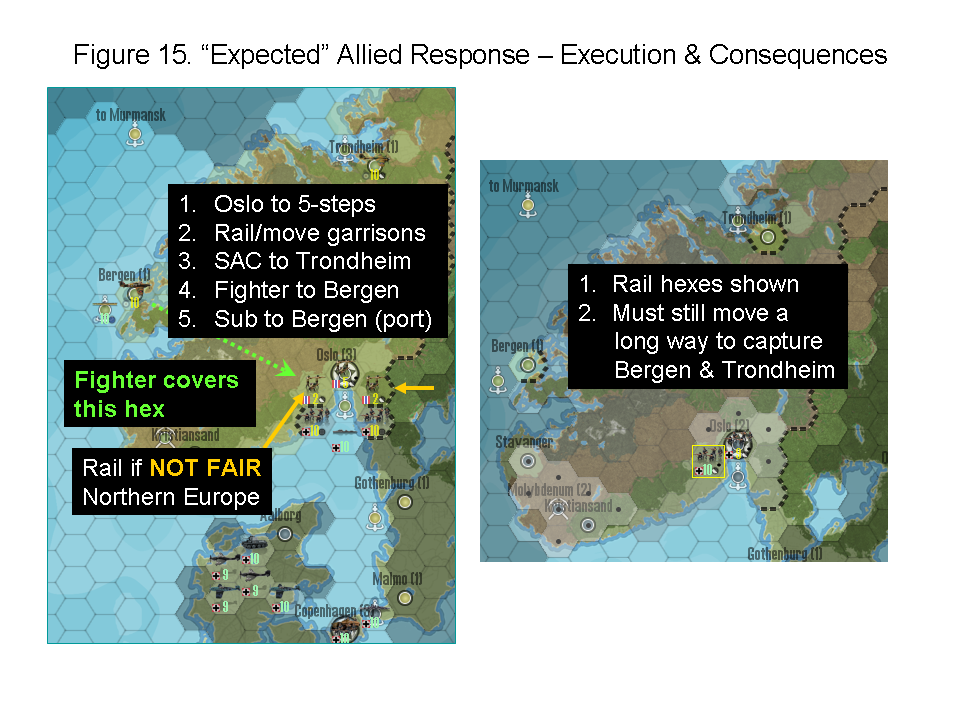The '39 Scandinavian Blitz
What is, "The '39 Scandinavian Blitz"? It’s a ’39 Blitz against Poland, Denmark and Norway followed by a 1940 fair weather invasion of France (i.e., Sitz). The Blitz-Sitz strategy has always been possible in GS; however, until recently there was a 4.7% chance that the invasion transports formed to invade Norway would have to abort with the loss of 16 PP’s for the cost of the transports. However; a recent change that’s included in GSv2.1 is that the cost of a transport is recovered for transports unloaded from friendly ports.
Another significant change in GSv2.1 is that the three garrisons defending Norway will spawn at 2-steps each provided Denmark was not invaded in a previous turn. Otherwise, they spawn at 10-steps each. Similarly for Denmark their two garrisons will spawn at 2-steps each provided Norway was not invaded in a previous turn. Otherwise, they spawn at 10-steps each. Defenders spawning at 2-steps versus 10-steps represent the effect where either or both of these countries are totally unprepared for war and have not mobilized. With respect to this effect Norway and Denmark are linked. If both are not invaded on the same turn then the country that’s invaded later is assumed to have mobilized, hence their defenders spawn at 10-steps and also will NOT suffer the surprise effectiveness loss. Thus, it’s advantageous to invade both Norway and Denmark on the same turn and the strategy presented herein is based on that. As a side note and unrelated to this strategy, Holland and Belgium are similarly linked and with their defenders spawning at less than full strength. However; if one of the two is invaded on a later turn the defenders for that later invaded spawn at full strength.
Why the Blitz-Sitz? In a number of games I will sandwich the invasion of Norway, and now Denmark, between the conquest of France and the invasion of the Balkans. Also, in those games where I may struggle through France due to a late spring or strength of my opponent resulting in an August capture of Paris, I am hard press to get the invasion of Norway in before bad weather strikes; especially, if I get unlucky in October with the weather rolls. Even with a normal fall of France (May – July), I like to support my invasion of Norway with 2, or better yet 3, sub flotillas and most of the Luftwaffe. I do this as a hedge against a strong allied intervention. In general, my experience has been that the allies don’t intervene except by sending air units to Bergen and Trondheim. However; there’s been a couple of games where my opponent sent a strong force of two transports supported by the RN and it was in those games where my strong supporting force of subs and air units were able to significantly blunt that intervention. In may be that in most games I don’t need these supporting forces but in those that I do it would be near disastrous (i.e., possibly conceding Norway to the allies) if I didn’t have them at hand. So my philosophy is better safe than sorry.
In 1939, the British might be more cautious about sending garrisons to Norway, since they might need all their units to defend against Sealion. Plus the allied player will need to consider transport costs while they're trying to ship units to France (even though these costs are eventually recoupable), the Home Guard rule in Britain, and trying to start their research too. All of these things might make the Allied player more passive when it comes to shipping garrisons to Norway. So by invading in 1939 you might avoid having to deal with the aggravation of a strong allied intervention. Also, since convoy sizes are smaller in ‘39 than in ‘40, 1939 would seem to be the ideal time to take the subs out of convoy hunting duty to screen for the Norway invasion. Additionally, since two flotillas are already there a ’39 invasion will actually save the axis a bit of oil versus a ’40 invasion where they would have to move the flotillas back from patrol in the Atlantic. More importantly in my opinion, “getting” Norway out of the way in ‘39” allows the axis player more flexibility after the fall of France. This flexibility can be manifest in both action (e.g., early invasion of the Balkans) and / or threat (e.g., Sea Lion). In effect the axis player is able to transition fully and with maximum focus (i.e., naval and air forces) to their next objective (e.g., Balkans, Sea Lion, rejecting the armistice and going for Spain, close the med) and without having to sacrifice Norway (e.g., Sea Lion or Spain). If nothing else a ’39 conquest of Norway means the axis player doesn’t need to fret if progress in France is proceeding slower than desired.
What are the risks? In any combat operation there are risks and this one is no different. With no allied intervention there is a 4.7% chance that is operation will have to be aborted due to weather alone. Of course this means a 95.3% chance that it will be carried. However; if aborted the transport costs of 16 PP’s for two transports can be recouped by unloading these transports from a friendly port. Thus the only “loss” for a weather only abort is a bit of oil. Now things get a bit trickier if the allies decide to intervene by sending a strong naval force to try to disrupt the Norway landings. First off the allied player on turn 1 must be expecting a Germany ’39 move on Norway and would have had to put their naval forces in harms to fully block such an invasion. The RN naval forces in harm’s way would be subject to German air, naval and sub attacks outside the coverage of the RAF. In this case the axis player could simply cancel the invasion before even forming the transports and got after the RN. A more subtle or reactive allied intervention would be one that forms outside of German air and naval spotting and then moves into and traps the German invasion forces in the Skagerrat straights (figure 1). But, in my opinion, the risks to the allies are far greater than the risks to the Germans. Whether permitting (75% chance), the Germans could still conduct their Norwegian landings, devastate allied naval units with German air and subs, capture Denmark which would open up access to the Baltic through the Kattegat straights and the port of Copenhagen. If the weather does not cooperate German air, naval and sub forces should be able to protect the invasion transports until they can land while pounding allied naval units outside of allied air coverage. Even in the worse case scenario where the weather never cooperates in ‘39 (4.7% chance) and the Germans are not able to land in Norway, their navy and invasion transports could still escape into the Baltic through the Kattegat straights by conquering Denmark. While this would make a ’41 conquest of Norway more difficult because their 3 garrisons would be fully mobilized to 10-steps each I think this difficulty would be more than offset by the losses that should have been inflicted on the RN and French navy by German navy, air and sub forces. I put the threat of this type of allied intervention and the subsequent risk of this type of abort as very low. And in fact, this low-risk scenario is even possible for a ’41 invasion of Norway especially for a late summer fall of France. I don’t want to exaggerate the risk from an aggressive allied intervention. The chance of it, I believe, is low and even if it does occur the consequences of it should be worse for the allies than the axis. This is war after all and all combat operations do carry some element of risk. I believe the benefits of this operation far out weight any potential risks and is; therefore; worth carrying out.

Figure 1. Denmark and Norway.
This completes my first installment. This first part was a bit short on pictures. However; the remainder will have lots of pictures and even includes a detailed probability tree for those interested in such things.















